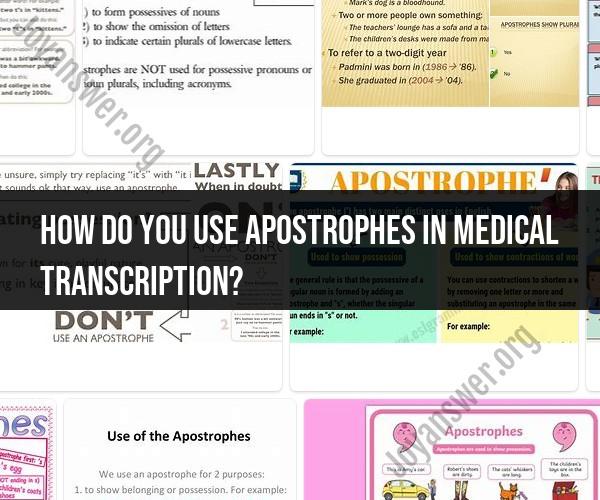How do you use apostrophes in medical transcription?
Apostrophes in medical transcription, as in any form of writing, are used to indicate possession and to create contractions. Here are some best practices for using apostrophes in medical transcription:
Possessive Forms:
- To show possession by a singular noun, add an apostrophe and an "s" ('s). For example, "the patient's history."
- To show possession by a plural noun that doesn't end in "s," add an apostrophe and an "s" ('s). For example, "the women's health clinic."
- To show possession by a plural noun that ends in "s," add only an apostrophe ('). For example, "the patients' records."
Contractions:
- Use apostrophes in contractions to indicate missing letters. For example, "it's" instead of "it is" or "they're" instead of "they are."
Avoiding Ambiguity:
- Be mindful of how apostrophes are used to ensure clarity in medical transcription. For example, "patients' rights" indicates the rights of multiple patients, whereas "patient's rights" would refer to the rights of a single patient.
Plurals:
- Generally, avoid using apostrophes to create plurals. For example, write "CT scans" instead of "CT scan's."
Units of Measurement:
- Do not use apostrophes in units of measurement, such as "cm" for centimeters or "mg" for milligrams.
Distinguishing Between Possessive and Plural Forms:
- Be careful when using possessive forms in medical transcription. For example, "the nurse's station" indicates the station belonging to a nurse, while "the nurses' station" refers to a station used by multiple nurses.
Hyphenation with Possessive Forms:
- When a possessive form appears in a compound modifier (e.g., "the patient's history-related issue"), use hyphens to connect the words for clarity.
Common Medical Terms:
- Some medical terms use apostrophes to indicate missing letters, such as "Hemoglobin A1c" (HbA1c), where the "o" in "to" is replaced by an apostrophe.
Acronyms:
- Acronyms that include possessive forms should be written with an apostrophe. For example, "GCS's" for "Glasgow Coma Scales."
Consistency:
- Maintain consistency in your use of apostrophes throughout the transcription to ensure clarity and professionalism.
Always proofread your medical transcription work to catch any errors or inconsistencies in the use of apostrophes. Following these best practices will help ensure accuracy and clarity in medical documents.













